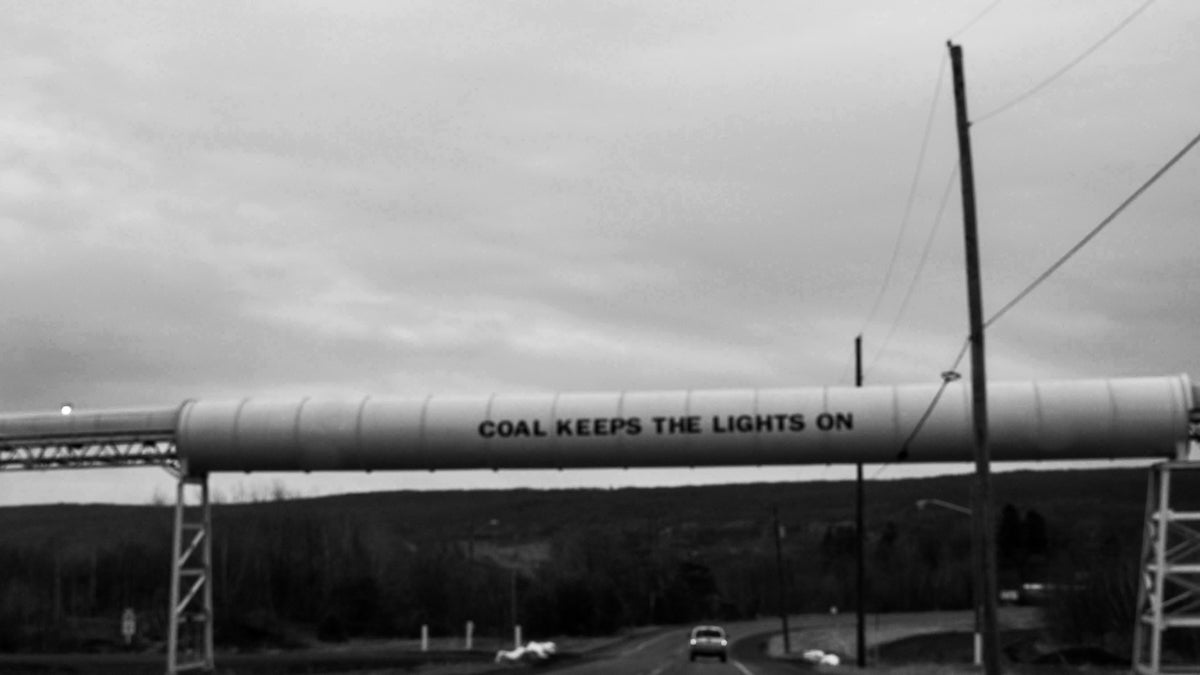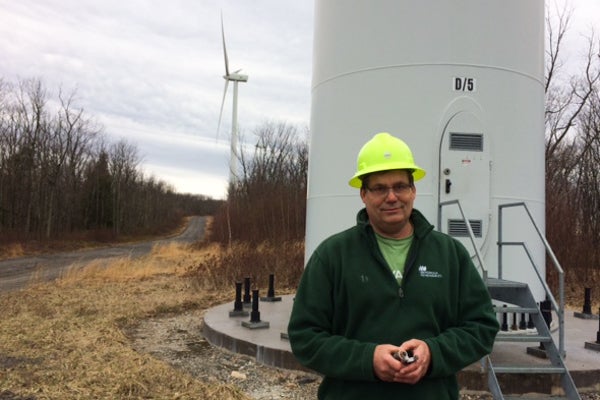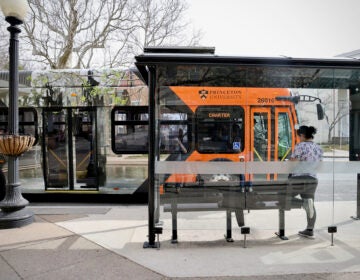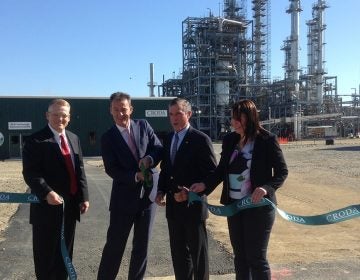Renewable energy jobs bring new life to old coal towns
Listen 6:42
This conveyor belt transports ash from burnt coal to a dump site near Shenandoah This conveyor belt transports ash from burnt coal to a dump site near Shenandoah. (Elizabeth Fiedler/WHYY)
In some former coal towns, residents continue to hold tight to that economy and identity.
Reporter Elizabeth Fiedler took a road trip home to Central Pennsylvania to see how coal country is changing.
When I leave Philadelphia, the tall buildings and traffic fade away. After a drive of more than two hours, it almost feels like a different planet. I’m surrounded by hills, a huge open sky, and trees everywhere.
The ghost of coal is all around me.
Like me, Lee Van Horn grew up out here. We’re in Central Pennsylvania standing by the side of a two-lane road in the small town of Shenandoah. We look up at a hulking old building rife with broken windows.
“They brought the coal out of the mines and then they broke it down [here] into different sizes. And that coal could be used both in industry and for home heat,” he said.
Van Horn is in his 50s now and lives just a few miles away. He points across the road from the coal mine, where a stone foundation is the only sign of the school he attended as a kid. Van Horn says as a boy he peered out the windows of St. Nicholas Elementary to watch the coal mining operation. The big trucks impressed him most.
Van Horn’s dad, and many others in his family, had jobs in the coal mines.
“My father worked in the deep mines just as a basic laborer,” Van Horn said.
His dad would tell him about what it took to be underground for hours each day.
“I’m glad I’m not doing it, let’s just put it that way,” Van Horn said.
It was dirty, dark, dangerous work, but it was a job he needed. When the coal mines closed, Van Horn says his dad had to find other ways to support the family — as a mechanic and a maintenance supervisor.
When Van Horn grew up, he had different options. On a ridge in the distance is a row of white wind turbines standing stark against the gray landscape. The 250-foot-tall towers are topped with three blades — each 130 feet long.
About every 5 seconds, depending on the wind speed, the blades spin full circle. Van Horn makes his living above ground in the wind industry. He is manager of the Locust Ridge Wind Power Project.

At the base of one of the turbines, Van Horn swivels a wrench to release the door bolt, and we step inside. The 64 turbines — run by Avangrid Renewables — produce enough energy each year to power 40,000 homes.
“So this is the inside of our particular model of Gamesa turbines. There’s not very much to see at the base of the turbine,” Van Horn said. “We have our man lift, or elevator, which can handle two people. That’ll take ’em up to the top of the turbines.”
In some other former coal towns, residents continue to hold tight to that economy and identity, but Van Horn says for very practical reasons many people here have accepted that it’s time to move on.
“At least the people that I interface with, they had a positive attitude toward wind power,” Van Horn said. “People realize that coal isn’t going to be around here forever and people need to re-tool themselves and get occupations within newer industries.”
In the area, coal is actually still being extracted through strip mining, but gone are the days when there was an abundance of jobs in the mines.
Many Pennsylvania coal towns have fallen on hard times — like Centralia, about 10 miles away. Thomas Dempsey used to work for the U.S. Postal Service there. Some people even consider him the official historian of the small town.
There’s not much of a town left.
The population has fallen from thousands to fewer than ten people. Many people slowly moved away after a mine fire broke out in Centralia decades ago. The fire is still burning.
Dempsey says the region’s challenges go well beyond the underground fire.
“After World War 2 the demand for anthracite coal for heating fuel for homes in the northeastern United States sort of ended. And people started using fuel oil, and gradually the coal mines went out of business and started closing down,” Dempsey said.
When the coal jobs left, many laborers did too, heading to Philadelphia and New Jersey to do industrial work.

For people who remain in these old coal towns, jobs in renewable energy can provide a new way of life. Mine closures reverberated throughout coal communities, putting people out of work in all sorts of related industries, from truck drivers to teachers.
Wendy Wasserman works for a federal-state partnership called the Appalachian Regional Commission that funds agriculture, manufacturing and renewable energy projects in former coal regions. One project, an electric cooperative in southwestern Virginia, produces energy from solar panels and trains locals for work in the solar industry.
In the past year, the organization has invested a big chunk of federal money: more than than $75.5 million across 236 coal-impacted communities in the region.
Wasserman says training is a good start, but to rebuild the job market in coal country, companies need to be willing to come to Appalachia.
“One of the biggest challenges is having folks outside the region believe in them. People in Appalachia are smart, they’re clever, they’re entrepreneurial, they’re feisty, they’re strong,” she said.
Like Lee Van Horn, the coal miner’s son who’s now managing a field of wind turbines, many proud coal country natives want to find a way to make a life — and a living — here.
WHYY is your source for fact-based, in-depth journalism and information. As a nonprofit organization, we rely on financial support from readers like you. Please give today.






